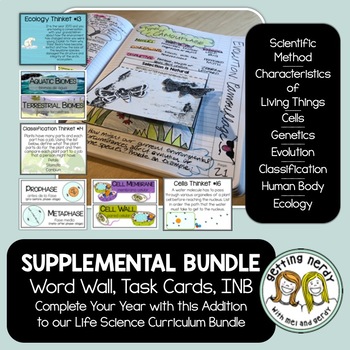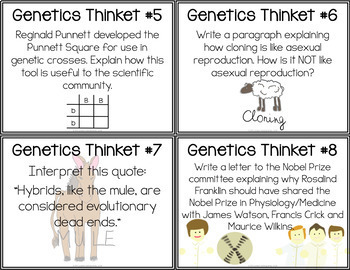Life Science Supplemental - Interactive Notebook, Word Wall, Task Card Bundle
- Zip
- Google Apps™

What educators are saying
Products in this Bundle (23)
showing 1-5 of 23 products
Description
Word walls? ✓
Interactive Notebooks? ✓
Task Cards? ✓
You're ready to teach with this comprehensive bundle to supplement your life science curriculum. Engage your students with over 200 Interactive Notebook activities, a year-long visual word wall with roots, suffixes and prefixes AND English and Spanish translations, and a set of versatile task cards for every topic in life science. You're all set! We are digitizing our products for use in Google Classroom and they will also be Microsoft Schools compatible. This bundle is growing and we will have INB and task cards completed as soon as we can. We are working hard!
WHAT'S INCLUDED in this YEAR-LONG BUNDLE:
• SEVEN Life Science Interactive Notebook Units and THREE supplemental packs including over 200 differentiated templates in blackline and color:
→ Cells and Cell Processes - DIGITAL COMPONENT COMPLETED
→ Scientific Method and the Nature of Science
→ Genetics and Heredity
→ Evolution
→ Classification
→ Human Body Systems
→ Ecology and Ecosystems DIGITAL COMPONENT COMPLETED
→ Introducing Interactive Notebooks
→ Back to School activities
→ End of Year activities
• Aligned Visual Word Wall cards with roots, suffixes, and prefixes for each word, as well as English only and English/Spanish translated cards
• Over 130 aligned task cards that can be used as warm-ups, exit tickets, project starters, and more! DIGITAL COMPONENT COMPLETED
THIS PAIRS PERFECTLY WITH OUR Life Science Biology Curriculum Bundle
SEE HOW THIS LESSON ALIGNS WITH THE NGSS, TEKS or GSE
Because we have created many of our own graphics or have purchased licenses to other graphics with permission, we cannot offer our resources in editable format unless otherwise stated.
TERMS OF USE (TOU):
All rights reserved by GETTING NERDY®️
• This product is to be used by the original purchaser only
• Intended for classroom and personal use only
• Copying for more than one teacher, classroom, department, school, or school system is prohibited
• This product may not be distributed or displayed digitally for public view
Failure to comply is a copyright infringement and a violation of the Digital Millennium Copyright Act (DMCA). Clipart and elements found in this PDF are copyrighted and cannot be extracted and used outside of this file without permission or license.
Life Science and Biology Supplemental Bundle: Interactive Notebook, Word Wall, Task Cards © 2012 to present Getting Nerdy ®️ All Rights Reserved





